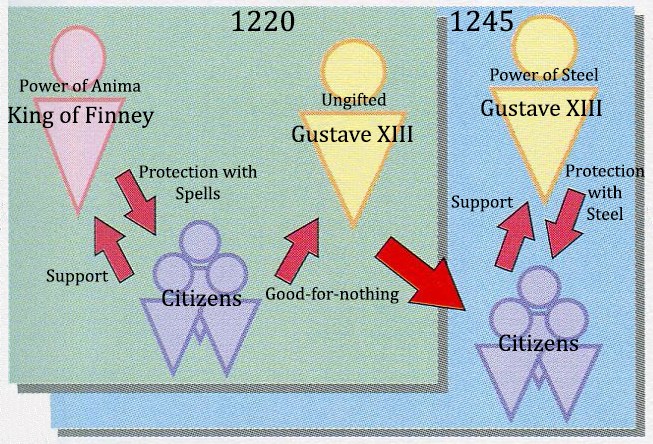♦ Divergence from Spell Culture (1200’s) ♦
In the early 1200’s, when Spell Culture reached its height with the development of Tools, it was impossible for those who could not use Spells to live even a meager life on the Eastern Continent. Being unable to use Spells meant not having the means to protect against foreign enemies. Not only that, but in the regions where Spell Culture had reached maturity, those who could not use Spells were thought to have no Anima and were considered evil.
Exile of the Prince
1227
It was an incident which shocked the people of Merchmin. The setting was the Kingdom of Finney, at the Castle in Thermes. The Royal Family uses the “Firebrand Ceremony” as a rite of passage to demonstrate to the people that the heir to the throne possesses Anima. However, the new Prince had none. This shocked not only the Palace, but people across the Kingdom. Possessing Anima was the minimum requirement for holding social status and was considered a means to protect the citizens. Yet the next King was found to be “defective” and the Prince was exiled from the Royal Palace. This was a necessary measure to calm the unrest of the people. The exiled Prince was Gustave XIII, the one who would bring about a huge divergence from Spell Culture.
The Rise of Steel
1248
For Gustave, who had no Anima, Steel armaments were an absolute necessity. He happened upon the technology while taking refuge on the Southern Continent, but that chance encounter was key in restoring basic rights to the Ungifted. Steel armaments were initially only manufactured in the territory of Gustave XIII, but when he advanced on the Eastern Continent, Steel goods spread quickly throughout Sandail almost as fast as the introduction of Tools.
Naturally, troops serving under Gustave were equipped with Steel and clashed in fierce battles against troops using Spells.
A Combination of Old and New
1305
The lost art of manufacturing Steel armaments, revived by those who could not use Spells, brought about more unrest in Sandail. However, it resulted in them being able to escape oppression and live normal lives. Those who used Spells to control the battlefield had to acknowledge this new era of Steel and adapt. When the apparition of Gustave XIII was defeated at South Moundtop, it was one step towards a world where both sides could coexist.
